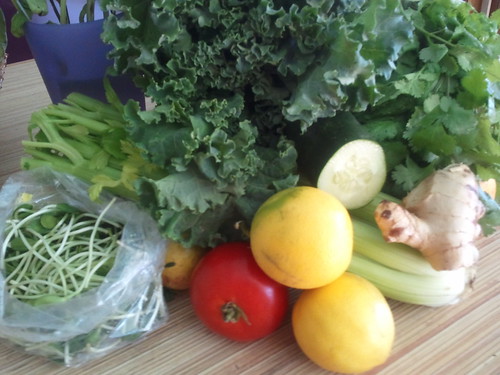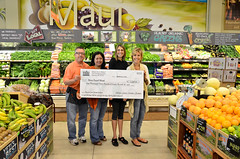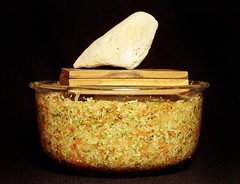I received the following question from Heidi, a mother in the US who just purchased the DVD's. My answer follows her question below:
Hi Susan,
I was hoping to ask you a couple of questions. I have really been enjoying all of your recipes very much. I wish I could say the same for my family. So far they have all voted against us all moving towards a raw food diet. My husband thinks I have gone off the deep end and my 16 year old, my 9 year old and my 1 1/2 year old are all terrified to see what our next meal will be made of. It is disheartening and very stressful for me to work so hard to make these meals (with a 4 month old and 1 year old pulling at me all day long and crying every time I am in the kitchen) to have my whole family not like them and request a second dinner of food they do like. I feel like I will have to always prepare 2 meals from now on... one for them and one for me. I want to live this raw food lifestyle for health reasons for myself and preventative measures for my family for possible future illness. I am finding it to be a very difficult way to eat so far (with my 2 little ones constantly pulling on me and the limited raw food supply here where I live etc.) but I do believe the end result for me is worth it completely. Do you have any suggestions?
Secondly I was wondering why you cook and or bake your vegetables and eat bread that has been baked? I have purchased a few other raw cooking books and they both say that NOTHING should be heated over 112 degrees. They say enzymes are killed after this heating point. I am confused. What is your opinion on this?
Thank you so much for your time!!
Heidi
Dear Heidi,
Your questions and your challenges are common I am sure. First, a little history. I created Essential Cuisine out of my own experience with food. In 1990 I became raw and remained Raw for 2 years. Then I started incorporating cooked food, out of convenience mostly as I traveled a lot. I continued my nutritional studies as I experimented with my own body. Within a few years of eating only raw and some cooked I began to get ill (fatigue and some skin issues) and also bone loss. Through my studies and 15 years of attending Natural Food Shows and many lectures on food and nutrition, I broadened my experimentation into eating some animal foods - mostly dairy and always raw.
After many years of studying a vast body of nutritional/culinary information I became confused. My body became my best teacher. My bottom line is now this: A good blend of Raw, Cooked and Cultured foods works best for me and many others. It keeps me nourished while I can still cleanse and fortify at the same time. If you study our indigenous cultures and also those cultures whose elderly live to be a healthy 100 years old, you will find that their diet is full of local fresh foods, both cooked and raw. And, they all have a naturally fermenting food in their diet such as a kefir, yogurt, cultured veggies, or grains. Naturally fermented "live" cultured foods are vital for any diet. Particularly if you are eating cooked foods and animal products. Fermented foods rich in probiotic bacteria and tons of enzymes (live cultured foods) will help greatly in building the friendly flora needed in the gut for digestion and proper assimilation, thus building immunity. I think putting these kinds of living foods in the diet are more important than whether your food is raw or cooked.
Many cultures eat a primarily "cooked" food diet and do quite well (India). In fact, many health practitioners think some foods are better for you cooked. Think about it this way. Would you be able to eat an adequate amount of mung beans or lentils if they were raw? Probably not. Cooking them allows you to eat much more of these fabulous foods, plus science is showing us that they are healthier when cooked. Also, consider vegetables. Many people do not like veggies and will not sit down to eat a huge bowl of them chopped raw. But, you can cook them slightly and put a great (raw) sauce on them and suddenly, you can eat more and they taste much better.
The answer as to why I prepare/teach/eat cooked foods along with raw foods is that I don't have a belief that people should eat only raw. Yes, enzymes may be lost, but that is not the only criteria for healthy food. My motto is to eat from the Earth and not the factory, and if you are going to eat animal foods, make sure the animal is as healthy as you want to be. Dairy is best raw. As for meat, grass fed is best. You can read about both of these concepts on my blog under articles.
As for your family I would not recommend trying to take them all the way to raw foods is there is resistance. First thing to do is to take all processed foods away and make lots of "natural - whole" foods available. You can mix raw and cooked foods together. This is in Essential Cuisine.
Make sure your fats are kept raw. In other words, do not cook with them. Use olive oil and high quality flax and coconut oils available for topping and/or sauces and dressings for cooked foods. Make the same foods your family loves, but use better ingredients. For instance, if your kids like pizza, then use a whole wheat pizza dough and top with fresh veggies. You can get lots of fresh salads with good dressings in their diet in any way that works. Give them what they love and then add in more nourishing whole foods. Luscious smoothies and lots of good juices can be beneficial. Soups are wonderful too. When cooking grains or veggies, remember low and slow is best. Raw food desserts is a great way to satisfy a sweet tooth.
It is not easy to transition someones diet especially when they do not want it. I have total compassion for what you are going through. My son was a rebel with me, and he really needed to stay on a very clean diet. He could not tolerate sodas, candy, pasteurized dairy, food chemicals, dyes, preservatives or foods with lots of sugar in any form. This is what you want to steer your family away from. If most people would just take processed foods, sugar and bad fats out of their diet their health would improve enormously. This is where I would start. Remove the junk and replace with whole foods. That is why I made sauces and dressings and showed you how to use great fats on ordinary foods. My methods do not take a lot of work. You can create your own seed milks too, and use them for smoothies and even boxed cereal if necessary.
Cook rice, potatoes and other whole foods and top with high quality fats and seasonings. Get creative in blending some of the ideas in a la Oils. This way you can bring your family along slowly and keep peace and joy in the house.
Meal time is extremely important for bonding and family time. The family must be nourished with joy as much as nutritional value. It won't work to push foods on them. Instead incorporate them into your meals and improve the quality of what your family members love.
I think you have asked a big question that many people have. Perhaps we can continue to discuss and find ways to keep it moving in a positive way.
Many blessings, Chef Teton














